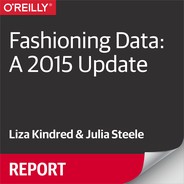Chapter 5. What’s Next?
The data was really our goldmine.
Veronika Sonsev, InSparq
The implications of what fashion is doing with big data has the potential to resonate among a huge variety of industries—potentially to anyone that makes or sells products.
Geoff Watts, CEO of the fashion analytics platform EDITD, told Fortune, “We help retailers have the right product at the right price and the right time. That’s the kingmaking thing in retail. When you get that right, it unlocks a fortune.”
Veronika Sonsev from InSparq put it this way: “The company’s first enterprise product was a sharing and rewards product. One of the things that we saw with that product was that even though that product worked really well—we could really optimize sharing—it still was only affecting a small portion of business. We got some great advice that encouraged us to think about ‘how can we take that small percentage of customers who share, and amplify what they do to benefit the rest of the customers.’ That’s when we started looking at the data, and seeing that the data was really our goldmine.”
Journalist Lorraine Sanders agrees: “My sense is that the biggest dividends from the use of big data are going to come with reduced friction in both getting products to market and getting them in front of the right eyeballs once they are there. That, in turn, has the potential to affect margins and open the door to new types of business practices and internal structures that could change the way fashion is sourced, made, and sold around the world.”
For so many industries, data can be a goldmine—and fashion has taught us some valuable lessons about how to make it happen.
The Big Wishes
Today, we’re able to do staggering things with big data: parse enormous datasets, predict the future with some level of accuracy, and other truly fantastic things. But, we’ve also got a long way to go. When we asked people what they wished big data was able to do that it can’t, the responses were enlightening.
Understanding Intent to Purchase
Lucie Greene, Worldwide Director of The Innovation Group, told us, “There is still an intangible emotive aspect to consuming, and digital (recordable) behavior only goes so far to explaining what inspires us to buy something. For example, if you’re in a store, you have surveyed the whole terrain of the store and only try on what you really like. When we’re online we’ll put anything into a shopping basket to store them for later. We’re much more fickle. Connecting the dots between the intent to purchase and the actual transaction will be the next phase. Already some exciting innovators are using facial recognition and neuroscience to understand our emotions on the screen and why we buy something.” She adds, “It’s difficult to predict what will have this effect based on previous behavior (digital or otherwise) because it’s such a subjective, individual, and emotional thing.”
When we asked Shawn Davis of ModCloth, which data parameter he would wish for, this was his answer: “One of the things that we struggle with at times is the context around why customers are coming to us. If I knew that [you were looking for a gift], I could help you connect with some of our great gift items, of which we have a ton. A lot of our customers are coming just for the entertainment of it for a few minutes. Being able to differentiate on some of those scenarios would be really helpful.”
Connecting Various Online Personas
Veronika Sonsev from InSparq has a different wish: “Right now, it’s hard to connect all of the versions of you that exist out there. Your version of you on your phone, and your version of you at your home computer, and maybe your work computer—those are still pretty tricky to connect. There are companies that are doing that, but it’s far from perfect. And really being able to see people across all of the different ways they connect online, and know that they’re the same person, that would be really powerful.” She adds, “It’s not that it’s completely impossible—it’s just that it’s not great.”
What Drives Purchases
Kevin Flammia from R.F. Madison would love to use big data to get an “understanding of what products are being purchased that people are never wearing. You might buy something, and even if you don’t return it, you just don’t ever wear it and it just sits in your closet because it doesn’t fit.” He goes on to say that, “understanding what the distribution is, specifically for men, of purchases driven by style and brand association versus fit. We know that there’s a tradeoff—some people will chose the same brand over and over again purely because they know it fits; other people have more of a brand attachment. Understanding that would be really helpful.”
